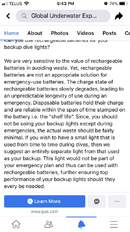This is why the DIR forum is dead. You get terrible advice here. Push button lights have failure risks that are not necessary to take, particularly for a backup. They will never be DIR. same for over volted bulbs. Yes it makes them brighter but it increases the risk of a failure when you turn it on. A bad decision for a backup light. Both risks are low but completely unnecessary to take.
The battery issue is more nuanced. It is less about testing now. Alkaline batteries are extremely reliable. The Lion stuff has a wider range of quality issues. For your true backups no need to take that small risk.
For dives where you really need the light if the primary fails most carry a second backup primary such as a handheld that does have lithium battery. Would I bother to do that on a dive with a 30 minute swim to exit no. But, for 2 hours on trigger to exit - yes.
If you are asking questions on a forum your diving is probably at a level where two scouts are all you need. Scouts, hesser, etc cost more because they are built like tanks to survive tons of abuse and just work. Highest reliability possible for the needed burn time is the goal of a backup not brightness, size, favorite color or other made up preference.
The battery issue is more nuanced. It is less about testing now. Alkaline batteries are extremely reliable. The Lion stuff has a wider range of quality issues. For your true backups no need to take that small risk.
For dives where you really need the light if the primary fails most carry a second backup primary such as a handheld that does have lithium battery. Would I bother to do that on a dive with a 30 minute swim to exit no. But, for 2 hours on trigger to exit - yes.
If you are asking questions on a forum your diving is probably at a level where two scouts are all you need. Scouts, hesser, etc cost more because they are built like tanks to survive tons of abuse and just work. Highest reliability possible for the needed burn time is the goal of a backup not brightness, size, favorite color or other made up preference.





